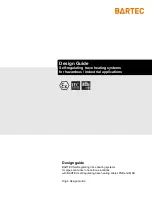
OPI-POWER LIFT HF 3S 12000-V1.0-EN
35
If the lift is to be assembled on an existing con
-
crete floor, cement quality and strength are to
be checked beforehand. In case of doubt, make
a test bore and insert a heavy-duty anchor. Then
tighten the anchor to the manufacturer recom-
mended torque.
After inspection within the anchor zone of influence
(see technical data sheet of the anchor manufac-
turer), if there is visible damage (hairline cracks,
cracks or similar), or if the required torque cannot
be applied then the set up location is unsuitable.
The following preparation and work steps are to be
done:
• To reach a higher level of protection against hu-
midity from the workshop floor, a thin PE foil should
be put between the workshop floor and column
base plate (2) before anchors are placed. Also,
the gap between the base plate and workshop
floor should be silicone sprayed after anchoring.
• Set up and position the lift.
• Fasten cross-beams above on the lifting columns.
•
Holes for floor anchoring (3) are to be made
through the holes in the base plates (2).
• Clean the bore holes by blowing them out with
air. Insert safety anchors into the holes (also see
8.6 Selecting anchor).
• Connect colour marked hydraulic lines (see Sec-
tion 3.5).
• Before anchoring the lift, check whether the con-
crete is of quality C20/25 up to the finishing level
of the completed floor. In this case, take the an
-
chor length from the anchor manufacturer’s data
sheet.
!
If there is a floor covering (tiles, screed) on the
weight bearing concrete, the thickness of this
covering must be determined. Afterwards, take
the anchor length from the anchor manufactur-
er’s data sheet.
• Position and align the lift and lift columns using a
bubble level.
Anchoring (symbol picture)
023
1 Column
2 Base plate
3 Positioning the fastening anchor
• The base plates (2) are also to be supported with
suitable underlays (thin metal strips) to ensure
precise vertical set up and contact between the
base plate and the floor.
• Tighten the anchors using a torque wrench.
!
Each anchor must be able to be tightened to
the torque specified by the manufacturer. Safe
operation of the lift is not guaranteed with a low-
er torque.
8.1.2
Riser extension (optional)
4
5
4 Riser extension (optional)
001
5 existing riser
Riser extension (4) is set on the existing riser (5). The
open side faces inwards.
4
4 Riser extension (optional)
003
• Set to the desired height (from 100 mm to 900 mm
in 100 mm steps).
i
Please consider the maximum ceiling height!
• Guide the 4 hydraulic lines that are fastened to
the operating columns upwards out of the riser.
• Afterwards, fasten the cover (6).
6
6 Cover for riser extension (optional)
004
Summary of Contents for HF 3S 12000
Page 2: ...2 OPI POWER LIFT HF 3S 12000 V1 0 EN ...
Page 4: ......
Page 19: ...OPI POWER LIFT HF 3S 12000 V1 0 EN 19 ...
Page 20: ...20 OPI POWER LIFT HF 3S 12000 V1 0 EN ...
Page 21: ...OPI POWER LIFT HF 3S 12000 V1 0 EN 21 ...
Page 22: ...22 OPI POWER LIFT HF 3S 12000 V1 0 EN ...
Page 53: ...Made in Germany POWER LIFT HF 3S 12000 Made in Germany Spare parts list ...
Page 60: ...60 OPI POWER LIFT HF 3S 12000 V1 0 EN 60 xx Switch box 000STA03600 2 05 07 19 ...















































